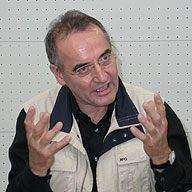An Interview with Erich Langjahr
Reality to the Film, the Film to You, and Then . . .
Q: Why did you choose the theme of farmers and farms?
EL: I’ve been interested in farms and farmers since childhood, and I played a lot at neighboring farms. Humans and animals have a simple way of coexisting in nature. That caught my interest. Also, I played with toys that were a miniature model of a farm. Those games gave me a really enjoyable sensation of looking around and seeing the big picture. I use the themes of farmland and farmers in my work because these images exist that were burned directly into my mind when I was a child.

Q: What is the process of turning reality into a film?
EL: First there is an image, which gives rise to an idea that I use to start filming on location. At this point I’m aiming to experience reality as a member of the audience more than as a director. And so I encounter the contradictions and gaps between the location and the images and ideas I’d created in my head beforehand. That is a wonderful thing. Instead of throwing out the reality that is at odds with my own ideas, I try to fit those gaps and contradictions themselves into the film. After peering through the viewfinder and experiencing reality like someone in the audience, I begin the stage of repeatedly analyzing the accumulated footage. I uncover the meaning hidden inside each and every element (image), and search for the logic that links each of the elements. Assembling them just like a puzzle, the elements that started out small gradually swell up and eventually develop into a large sequence. For this film, at this stage I had a rough cut a little less than three hours long. Then I move into editing, keeping dramaturgy in mind. Bringing the piece to completion is a poetic operation dictated by a rhythm that resides deep within me. I develop the structure in a way that incorporates my own personal cinematic and musical rhythm with journalistic, folklorist and other perspectives, so that all of this is reflected in the film. In that sense, you could say this film is at once fact and fiction. For me, there is hardly any distinction between narrative and documentary film. The single difference is that people who actually exist appear in documentary films, as opposed to narrative films where mainly actors perform. One big hope I have for documentary film is for the story developing on screen to become a reality for the audience. My approach to film can be explained as a triangle with three vertices: reality, the work, and the audience. I render the reality I experienced as a film, which I hand over to the audience. If the film becomes reality for the audience, then the three sides are assembled and the triangle is completed. True to my name (Langjahr), perhaps I gave a lengthy explanation? (Note: Lang means “long” in German.)
Q: Indeed things didn’t go like I’d expected, and the gap between image and reality that you talked about is wonderful (laughs). Is there anything else you’d like to add?
EL: I was able to complete this work because of the many kinds of assistance I received from Silvia (partner and wife Silvia Haselbeck). I am truly grateful. We’ve been working together for a long time, so just like the couple that appears in the film, we sometimes had conflicts too. I’ll be in Yamagata for the entire festival. If you’d like to talk more, just give me a holler any time (laughs).
(Compiled by Wada Hiroshi)
Interviewers: Wada Hiroshi, Takeda Chisato / Interpreter: Watanabe Mari
Photography: Sato Akari / Video: Oki Masaharu / 2003-10-11
